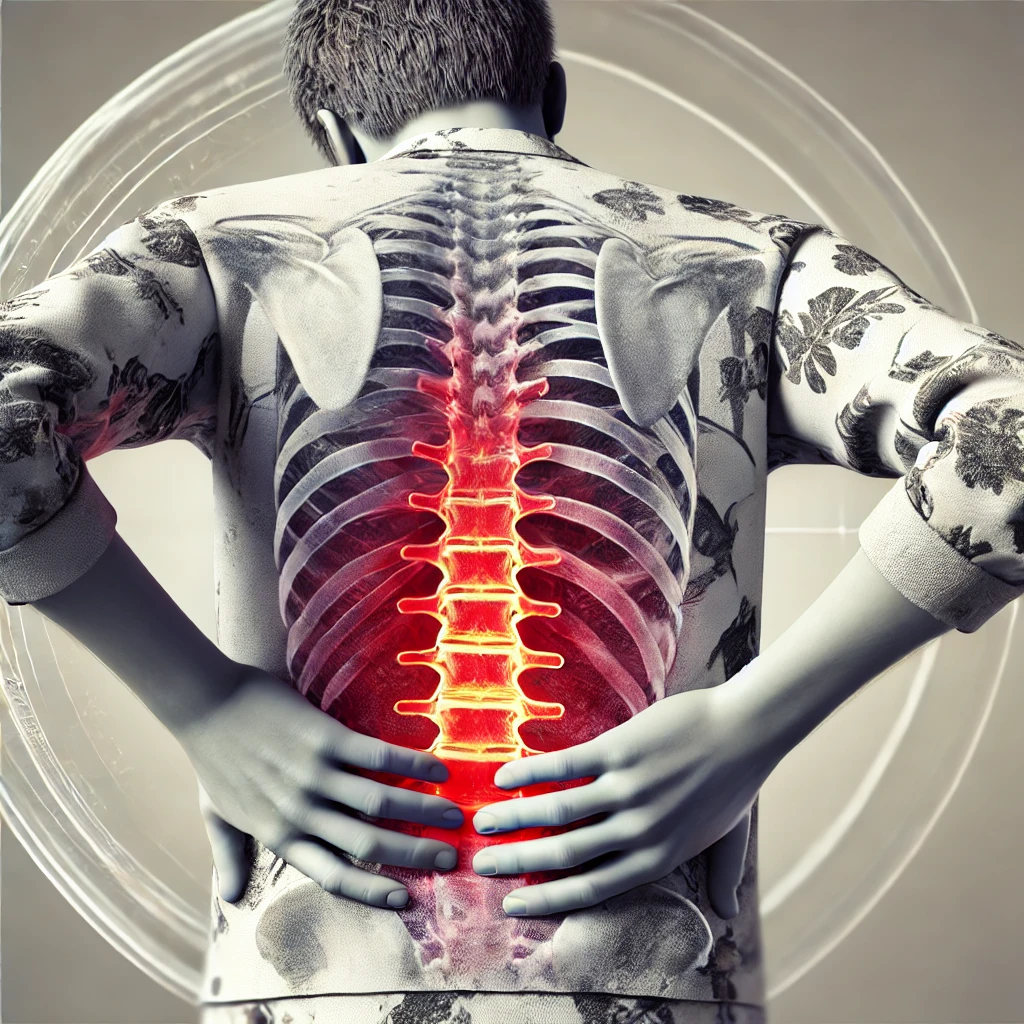Back pain is a widespread issue that can affect individuals of all ages. It varies in severity, from mild discomfort to debilitating pain, and can significantly impact daily activities, work, and overall quality of life.

Types of Back Pain
Back pain can be categorized based on its duration and underlying causes:
- Acute Back Pain: Temporary pain lasting a few days to a few weeks, often resulting from muscle strain, injury, or poor posture.
- Chronic Back Pain: – Persistent pain lasting more than three months, potentially linked to conditions such as arthritis, disc degeneration, or nerve issues.
- Mechanical Back Pain: Pain caused by movement, improper posture, or strain on muscles, ligaments, and joints.
- Radicular pain: – Pain resulting from nerve compression or irritation, which can radiate down the legs, as seen in conditions like sciatica.
Common Causes of Back Pain
Several factors contribute to back pain, including:
- Muscle Strains & Sprains: Often due to heavy lifting, abrupt movements, or poor posture.
- Herniated or Bulging Discs: When spinal discs exert pressure on nerves, leading to pain.
- Degenerative Disc Disease: Age-related spinal disc wear and tear.
- Arthritis inflammation within the spine, causing stiffness and discomfort.
- Osteoporosis: A condition that weakens bones, raising the risk of fractures.
- Sciatica nerve compression causing radiating leg pain.
Symptoms of Back Pain
Back pain may present itself in different ways, such as:
- Persistent dull, aching, or sharp pain in the upper, middle, or lower back.
- Stiffness or restricted mobility.
- Radiating pain down the legs, particularly when nerve compression is involved.
- Muscle weakness, tingling, or numbness.
- Increased pain after prolonged sitting, standing, or movement.
Treatment & Management of Back Pain
There are several ways to manage and treat back pain, including:
- Rest & Posture Correction – Avoid prolonged inactivity and maintain proper posture.
- Physical Therapy & Exercise – Strengthening the core and improving flexibility.
- Pain Relief Medications – Over-the-counter NSAIDs, muscle relaxants, or topical treatments.
- Heat & Cold Therapy – Using hot and cold packs to ease inflammation and discomfort.
- Chiropractic Care & Massage Therapy – Aiding spinal alignment and muscle relaxation.
- Surgical Intervention (Severe Cases) – Procedures like spinal fusion or disc replacement if non-invasive treatments are ineffective.
Preventing Back Pain
Taking proactive steps can help reduce the risk of back pain:
- Maintain a healthy weight to lessen strain on the spine.
- Engage in regular exercise to strengthen back and core muscles.
- Practice proper posture while sitting, standing, and lifting objects.
- Use ergonomic workstations and supportive mattresses for spinal alignment.
- Stay active and avoid prolonged sedentary periods.
1. Cat-Cow Stretch
This movement enhances spinal flexibility and helps relieve tension in the lower back.
How to do it:
- Start on all fours, aligning your wrists under your shoulders and knees under your hips.
- Inhale, arch your back, lifting your head and tailbone towards the ceiling.
- Exhale, round your spine, tucking your chin to your chest.
- Repeat for 10-15 repetitions, maintaining smooth transitions.
2. Child’s Pose
A gentle stretch that alleviates tension and promotes relaxation in the back muscles.
How to do it:
- Begin on all fours, then push your hips back onto your heels.
- Stretch your arms forward and rest your forehead on the floor.
- Hold for 30 seconds to a minute while taking deep breaths.
3. Cobra Stretch
This stretch engages the upper back muscles and enhances posture.
How to do it:
- Lie on your stomach with hands placed under your shoulders.
- Push through your palms to lift your chest while keeping your elbows slightly bent.
- Hold for 10-15 seconds and slowly lower down.
- Repeat for 3-5 repetitions.
4. Seated Twist
A great way to improve spinal mobility and reduce stiffness in the mid-back.
How to do it:
- Sit with your legs extended, then cross one leg over the other.
- Place the opposite elbow on the outside of your bent knee.
- Gently twist your torso, holding the position for 10-15 seconds.
- Switch sides and repeat.
5. Bridge Pose
This movement strengthens the lower back and core muscles, enhancing stability.
How to do it:
- Lie on your back with knees bent and feet flat on the floor.
- Lift your hips upward, engaging your glutes and core.
- Hold for 10-15 seconds, then lower down.
- Repeat for 3-5 repetitions.
Additional Tips for a Stronger Back
- Maintain proper posture while sitting and standing.
- Incorporate strength training exercises like rows, pull-ups, and deadlifts.
- Stay active and avoid prolonged sitting periods.
- Listen to your body and seek medical advice if pain persists.
By incorporating these simple stretches into your routine, you can improve back strength, enhance flexibility, and reduce pain. If any discomfort arises, consult a healthcare professional before continuing with these exercises. A well-balanced approach to back care will contribute to a healthier and pain-free lifestyle.
Read more posts on X

